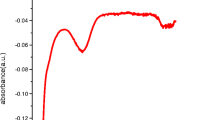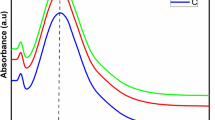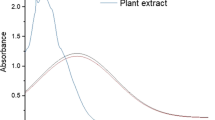Abstract
The present study reports a simple environmental-friendly process for the synthesis Gold@silver@silver chloride nanoparticles (Au@Ag@AgCl NPs) by using peel extract of Benincasa hispida (ash gourd) without using any toxic external reagents and external halide source. The synthesized nanoparticles were well characterized by using XRD, FT-IR, UV, TEM, and EDX analyses. The phytochemicals present in the peel extract were responsible for the formation of the nanoparticles. The synthesized Au@Ag@AgCl NPs showed an excellent photocatalytic activity for the degradation of toxic dye under solar irradiation. Approximately, 98% degradation of toxic dye was observed using Au@Ag@AgCl NPs as a photocatalyst under solar irradiation.
Access provided by Autonomous University of Puebla. Download conference paper PDF
Similar content being viewed by others
Keywords
1 Introduction
Nowadays, noble metals NPs like Pd, Au, Ag, and Pt have attracted considerable interest because of their unique property, surface plasmon resonance (SPR), showing excellent optical, electrical, and catalytic properties [1, 2]. Recently, many studies have been reported for the synthesis of alloy, core–shell, core–double shell, metal–metal halide nanoparticles (NPs) using toxic chemicals and solvents [3,4,5,6,7,8]. The utilization of these highly toxic chemicals and solvents makes the environment polluted, and therefore, the development of totally green synthesis is very important to reduce environmental pollution. Therefore, biosynthesis using plant-based materials has been exploited for the green fabrication of various NPs.
Keeping in view the shortcoming of previous studies, we design a green method for the synthesis of Au@Ag@AgCl NPs using biomaterial (Benincasa hispida peel extract). It was for the first time a green method for the synthesis of Au@Ag@AgCl NPs was reported using B. hispida peel extract. The phytochemical presents in the peel extract helped in the formation of NPs. The synthesized nanoparticles were further confirmed by EDX, XRD, TEM, and UV–visible spectroscopy.
2 Materials and Methods
2.1 Materials
The starting materials were of AR grade silver nitrate (AgNO3), hydrogen tetrachloroaurate monohydrate (HAuCl4·3H2O), and malachite green oxalate (MGO) was purchased from Sigma-Aldrich, Silchar.
2.2 Preparation of Benincasa Hispida Peel Extract
A total of 10 g of fresh peel of B. hispida was boiled for 30 min with 250 mL of distilled water in a round-bottom flask. The peel extract was filtered using Whatman No. 41 filter paper to obtain the pure extract.
2.3 Synthesis of Au@Ag@AgCl Nanoparticles
The biosynthesis of Au@Ag@AgCl nanoparticles was synthesized by using 20 mL of 10% B. hispida peel extract with HAuCl4·3H2O:Ag NO3 (1:1 molar ratio) by heating at 70 °C for 20 min.
2.4 Characterization of Au@Ag@AgCl Nanoparticles
Absorption spectra were recorded on Cary 100 BIO UV–visible spectrophotometer. The prepared nanoparticles were characterized by P-XRD method using Phillips X’Pert PRO diffractometer with CuK radiation of wavelength 1.5418. For the morphology study, FT-IR spectroscopy and elemental study, JEM-2100 transmission electron microscope, Bruker Hyperion 3000, FEG-SEM, Model: JSM-7600F, Magnification: ×25 to 1,000,000a have been used.
2.5 Photocatalytic Study of Au@Ag@AgCl Nanoparticles
The photocatalytic activity of the synthesized Au@Ag@AgCl nanoparticles was evaluated by degradation of toxic dye like malachite green oxalate (MGO). A total of 0.02 g of the catalyst was dispersed in 250 ml of MGO (6 × 10−4 M) aqueous solution. The experiment was carried out on a sunny day at Silchar City, Assam, between 10 a.m. to 2 p.m. (outside temperature 35–40 °C).
3 Results and Discussion
3.1 UV–Visible Analysis
Ag and Au NPs have unique phenomena known as surface plasmon resonance (SPR). Figure 1 represents the UV–visible spectrum of Au@Ag@AgCl nanoparticles. Figure 1 shows two absorption bands, one at 400 nm and another at 530 nm. The absorption band at around 400 nm is due to SPR of silver nanoparticles presence on the surface of AgCl nanoparticles, and the absorption band at 530 nm is due to the SPR of gold.
3.2 Morphology Study
Figure 2 corresponds to the TEM images of the synthesized Au@Ag@AgCl NPs. The TEM images revealed that the particles are spherical in morphology. The average particles sizes of the synthesized Au@Ag@AgCl nanoparticles were found to be (15–25) nm.
3.3 X-Ray Diffraction (XRD) Studies
The characteristic XRD peaks at 27.8°, 32.2°, 46.2°, 54.9°, and 57.6° were corresponded to the lattice planes of (111), (200), (221), (311), and (222) and also reflected the face-centered cubic (FCC) structure of AgCl crystal (JCPDS No. 31-1238) (Fig. 3). The remaining peaks at 38.2°, 66.4°, and 77.2° were corresponded to the lattice planes of (111), (220), and (311) reflected the face-centered cubic (fcc) structure of Au–Ag (JCPDS file: 65-2871).
3.4 FT-IR Spectroscopy Study
Figure 4 represents FT-IR spectra of the synthesized NPs. The FT-IR spectrum showed absorption bands at 3445 cm−1 correspond to hydrogen bonded O–H stretching vibrations of alcohols. The absorption peak at 1731 cm−1 could be attributed to C=C stretching vibrations of about C=O amide conjugated C=O of the proteins that are responsible for capping and stabilizing of Au@Ag@AgCl NPs. The remaining absorption peaks at 1634, 1452, and 1023 cm−1 were due to the presence of –C=O asymmetric stretching vibration, aromatic stretching of –C–N, C–H group (aromatic), respectively.
3.5 Energy Dispersive X-Ray Spectroscopy
The elemental analysis of the synthesized nanoparticles was performed using EDX. In the spectrum, the peaks around 2.2–2.5 keV correspond to Au, 3 keV correspond to Ag, and 2.7 keV correspond to binding energies of AgCl (Fig. 5).
3.6 Evaluation of Photocatalytic Activity of Au@Ag@AgCl Nanoparticles
The photocatalytic activity of the synthesized nanoparticles was carried out by monitoring the changes in optical absorption spectra of malachite green oxalate (MGO) solution under solar irradiation. The UV–visible spectra of the dye (MGO) showed a strong absorption band at 615 nm (Fig. 6a). The absorption band at 615 nm gradually decreases with increase in irradiation time and disappears completely within 110 min. The degradation of dye followed the pseudo-first-order reaction, and its kinetics may be expressed by the following reaction
where k is the rate constant, C0 and C t are the absorbance or concentration before and after degradation of MGO dye, respectively. The rate constant for the photodegradation of MGO dye was calculated using Eq. (1). Figure 6b represents the plot of ln (C0/C) versus irradiation time (t), and it gives a linear relationship. Hence, the slope of the line represents the rate constant (k) for the photodegradation of MGO dye and the value of k is found to be 4.66 × 10−2 min−1.
The percentage efficiency of photodegradation of MGO dye was determined using the following equation
where C0 and C are the absorbance or concentration before and after degradation of MGO dye, respectively. Figure 6c shows the percentage efficiency of photodegradation of MGO dye with time and observed that 98% of the dye was photochemically degraded within 110 min using Au@Ag@AgCl nanoparticles.
3.7 Mechanism of Photodegradation of Malachite Green Oxalate Dye Using Au@Ag@AgCl NPs
Due to the SPR effect of Ag metal, NPs present on the surface of AgCl nanoparticles, and an electron–hole pairs on the surface of Ag NPs were generated under visible irradiation. The electrons will be trapped by adsorbed O2 to form •O −2 . In the meantime, the holes were transferred to the surface of AgCl because of the high oxidation ability of the chloride ion present in AgCl and lead to the oxidation of Cl− ions to form Clo atoms (radicals) [9, 10]. In the photodegradation of MGO dye, Au NPs do not show any photocatalytic activity because of trapped by Ag and AgCl NPs that makes it unable to absorb the light.
4 Conclusions
In summary, we developed a green method for the production of Au@Ag@AgCl nanoparticles using B. hispida peel extract. The phytochemical presents in the peel extract acts as reducing and stabilizing agent during the synthesis of Au@Ag@AgCl NPs. The UV–visible spectroscopy, XRD, EDX, and FT-IR spectroscopic studies confirmed the formation of Au@Ag@AgCl NPs. The synthesized Au@Ag@AgCl NPs were successfully utilized as a photocatalyst for the degradation of MGO dye under solar light. The strong SPR effect of Ag NPs can generate electron–hole pairs and leading to the enhancement of the photocatalytic activities of Au@Ag@AgCl NPs. The reactive species, such as •O −2 and Cl0, are mainly responsible for the degradation of malachite green oxalate dye.
References
Devi, T.B., Ahmaruzzaman, Md., Begum, S.: A rapid, facile and green synthesis of Ag@AgCl nanoparticles for the effective reduction of 2,4-dinitrophenyl hydrazine. New J. Chem. 40, 1497–1506 (2016)
Devi, T.B., Begum, S., Ahmaruzzaman, M.: Photo-catalytic of plasmonic Ag@AgCl nanoparticles (synthesize via a green route) for the effective degradation of Victoria green B from aqueous phase. J. Photochem. Photobiol., B 160, 260–270 (2016)
Devi, T.B., Ahmaruzzaman, M.: Bio-inspired sustainable and green synthesis of plasmonic Ag/AgCl nanoparticles for enhanced degradation of organic compound from aqueous phase. Environ. Sci. Pollut. Res. Int. 23, 17702–17714 (2016)
Chaudhuri, R.G., Paria, S.: Au and Ag/Au double-shells hollow nanoparticles with improved near infrared surface plasmon and photoluminescence properties. J. Colloid Interf. Sci. 461, 15–19 (2016)
Ghosh, T., Satpati, B., Senapati, D.: Characterization of bimetallic core-shell nanoring synthesized via ascorbic acid controlled galvanic displacement followed by epitaxial growth. J. Mater. Chem. C. 2, 2439–2447 (2014)
Knauer, A., Eisenhardt, A., Krischok, S., Koehler, J.M.: Nanometer precise adjustment of the silver shell thickness during automated Au–Ag core–shell nanoparticle synthesis in micro fluid segment sequences. Nanoscale 6, 5230–5238 (2014)
Kulkarni, A.A., Bhanage, B.M.: Ag@AgCl nanomaterial synthesis using sugar cane juice and its application in degradation of Azo dyes. ACS Sustain. Chem. Eng. 2, 1007–1013 (2014)
Haldar, K.K., Kundu, S., Patra, A.: Core-size-dependent catalytic properties of bimetallic Au/Ag core-shell nanoparticles. ACS Appl. Mater. Interfaces. 6, 21946–21953 (2014)
Wang, P., Huang, B.B., Qin, X.Y., Zhang, X.Y., Dai, Y., Wei, J.Y., Whangbo, M.H.: Ag@AgCl: a highly efficient and stable photo catalyst active under visible light Angew. Chem. Int. Ed. 47, 7931–7933 (2008)
Wang, P., Huang, B.B., Zhang, X.Y., Qin, X.Y., Dai, Y., Wang, Z.Y., Lou, Z.Z.: Highly efficiently visible light plasmonic photocatalyst Ag@Ag(Cl, Br) Ag@AgCl-AgI. Chem cat Chem. 3, 360–364 (2011)
Acknowledgements
The authors would like to express their heartfelt thanks to the Director, NIT Silchar for providing laboratory facilities and financial assistance. Our special thanks are extended to SAIF-NEHU Shillong, SAIF IIT Bombay, and CSMCRI Gujarat for providing the TEM, EDX, and XRD facilities.
Author information
Authors and Affiliations
Corresponding author
Editor information
Editors and Affiliations
Rights and permissions
Copyright information
© 2019 Springer Nature Singapore Pte Ltd.
About this paper
Cite this paper
Babita Devi, T., Ahmaruzzaman, M. (2019). Bio-inspired Facile and Green Synthesis of Au@Ag@AgCl Nanoparticles Using Benincasa Hispida Peel Extract and Their Photocatalytic Activity for the Removal of Toxic Dye Under Solar Irradiation. In: Kalamdhad, A., Singh, J., Dhamodharan, K. (eds) Advances in Waste Management . Springer, Singapore. https://doi.org/10.1007/978-981-13-0215-2_38
Download citation
DOI: https://doi.org/10.1007/978-981-13-0215-2_38
Published:
Publisher Name: Springer, Singapore
Print ISBN: 978-981-13-0214-5
Online ISBN: 978-981-13-0215-2
eBook Packages: Earth and Environmental ScienceEarth and Environmental Science (R0)











